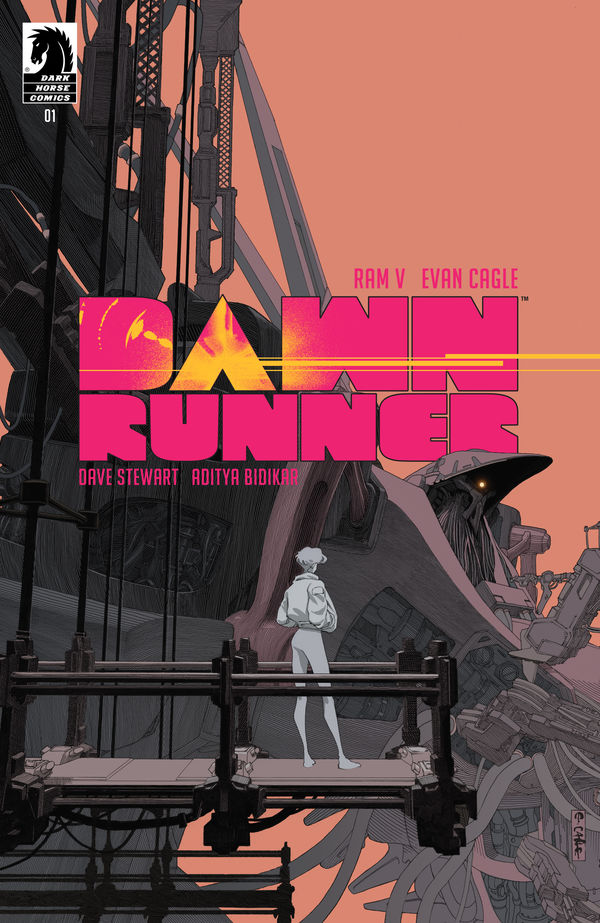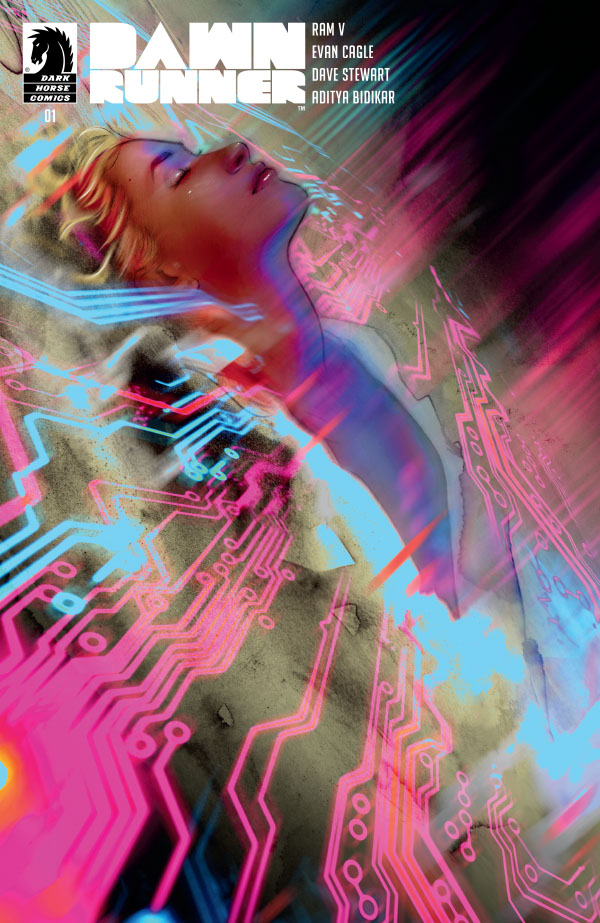“It Was Serendipity”: Ram V and Evan Cagle on the Collaboration, Kaiju and Connections of Dawnrunner
When I first heard of the idea that would eventually become Ram V, Evan Cagle, Dave Stewart, and Aditya Bidikar’s upcoming Dark Horse Comics miniseries Dawnrunner, I was all in. It was when Ram guested on Off Panel, and the writer suggested to me he was working on a new book that was effectively a kaiju/mecha story as told by the people who made Arrival, the Denis Villeneuve-directed film starring Amy Adams. That was all it took, because I knew that was two things. It was a special idea that fit me like a glove, and it was something I’d never experienced before. And now that I’ve read the first issue, I can tell you this: my first instinct was right. It’s incredible, something that has the potential to be one of the strongest works of the year.
For those that don’t know, here’s what the book is all about, straight from the solicit.
A century ago, a portal opened over Central America and giant monsters known as the Tetza came through, changing our world. Now, the world puts all its effort into making the Iron Kings–giant mechs that are forever battling the Tetza for humanity’s continued survival in gladiatorial combat. Anita Marr is the greatest of the Iron King pilots, chosen to work with a new secret prototype named Dawnrunner. An Iron King that could change the tide in humanity’s favor.
Given that it’s accidental Ram V Week here on the site, getting the chance to read Dawnrunner’s first issue made this the perfect time to chat with the writer and his collaborator in artist Evan Cagle about this series, so that’s what recently we did on Zoom. Ram and Evan joined me for an extended chat about the origins of this book, Cagle’s big swing for his first solo project, the impact of their collaborators, some of the big ideas in its world, the mechs of the book, and a whole lot more. This is honestly a delightful chat, and one I suspect you’ll enjoy, even if you haven’t read the comic yet (because it arrives on March 20th).
You can read this interview, which has been edited for length and clarity, below. It’s open to non-subscribers, but if you enjoy what you read, please consider subscribing to the site for more like it.
Ram, you had previously said on my podcast that your pitch for Dawnrunner was effectively, what if the standard kaiju mecha movie was made by the people who made Arrival. We didn’t dig into that then because I didn’t know what it was at the time, but I wanted to ask, what made that combination such an interesting one for you as a storyteller? Something that you wanted to build out into what this ended up becoming?
Ram: I’ve been an anime fan and manga fan for the longest time, and I watched a lot of the classic “big robots go fight monsters,” anime. Watching the sort of contemporary storytelling takes on it, I think the genre felt like it was going down the “Look, the monsters and the giant robots are the interesting things.” And for me, good sci-fi has always been about, “What are we saying about us as people and what are we exploring about us as human beings through the story of these kind of gigantic stand-ins or metaphors?” And I felt like there wasn’t anything recently that I had read, certainly in the American comics or European comics version of those things, that had quite done that.
And I remember distinctly feeling the same way about watching Arrival, where it was like, yes, it’s an alien landing movie, but this one distinctly focused more on what it says about us as people and how we deal with not knowing. That was my intention behind this, to take the genre and go, “Yes, but what if we focus on what it says about us as human beings more than we focus on the mechas and the kaijus,” which is all there too, of course.
This is going to sound like an insult to the book, but the mechs and kaijus the medicine that makes it all go down easier. You can really appreciate the human drama because you came for big monsters, but then you’re like, “Oh, I’m learning about human connection and this connection across time” too.
Ram: To be honest, I don’t think that’s a shade on the book at all. It’s pretty much my entire creator-owned career. “Hey, what if we took sixties New York noir and told stories about what it’s like to live in a strange city like Mumbai?” which was Black Mumba. “Hey, what if we took sixties New York jazz and told a story about generational trauma and the pursuit of genius and success through it?” that became Blue in Green. Laila Starr… “What if we took Indian gods and life and death personified?” which is, again, a genre considering Gaiman and Daytripper have done that so well. “Then told the story about human life and its beauty and its sanctity through it?” So, this is something that I’ve pretty much done on all my creator-owned books. I enjoy doing it…taking a window that is familiar to people and then using that as a way to get at things that defy or transcend the ideas of genre.
Human connection is a story that you can tell across genres.
Evan: It seems like in maybe the last 20 years in sci-fi and fantasy, we’ve sort of moved away from the idea that the things that make those genres genre-specific are somehow agnostic to the personal stories. So it’s a story about a couple getting divorced, but the backdrop is giant monsters or the backdrop is a fantasy setting. And to me, you’re missing the opportunity to talk about why the genre is important. If they live in two separate camps, if the concerns of the characters live separately from the overall themes of the story, the overall world that you’ve created, somehow, they’ve got to work together.
Ram: You’re leaning dangerously close into my favorite topic of discussion, which is Star Wars versus Star Trek. You could tell Star Wars as a fantasy story and it would be Game of Thrones-esque. You could tell Star Wars as a crime story, and it would be down to earth, grounded…
Evan: Right. So, what is it specifically about the world of Star Trek that makes the stories work? Inherently, they’re meshed together. It can’t live separately from it.
Ram: Absolutely.
Ram, I know Evan was one of your Instagram loves, an artist you were fawning over from afar. Was Dawnrunner developed with Evan in mind as the artist or did you just eventually pitch him on it after you developed it?
Ram: It germinated before I had found Evan’s work. It germinated from watching…I think it was somewhere around the time I was watching Pacific Rim really. I remember discussing it with some of the White Noise guys 1 and then I said, “Yeah, one day when my schedule clears up.” I think at the time I was working on…it might’ve been Blue In Green that I was working on at the time, and so it was after that I found Evan’s work, and one illustration in particular. Evan has an illustration called Golgotha, which shows a young man standing in front of this giant mech that is towering over him. And I looked at that illustration and it blew my mind, because I could now see this idea that I had in my head, and I could visualize it in this style. And I went, “Oh my God, this person is amazing. Their work is amazing. I have to get in touch when I come around to making this book.”
And then lo and behold, shortly after that, Evan got in touch and went, “Hey, we’re following each other. I read Grafity’s Wall and I loved what you guys did with that book, so I would love to collaborate on things at some point in the future.” It was serendipity, so I said, “Yes, perfect.”
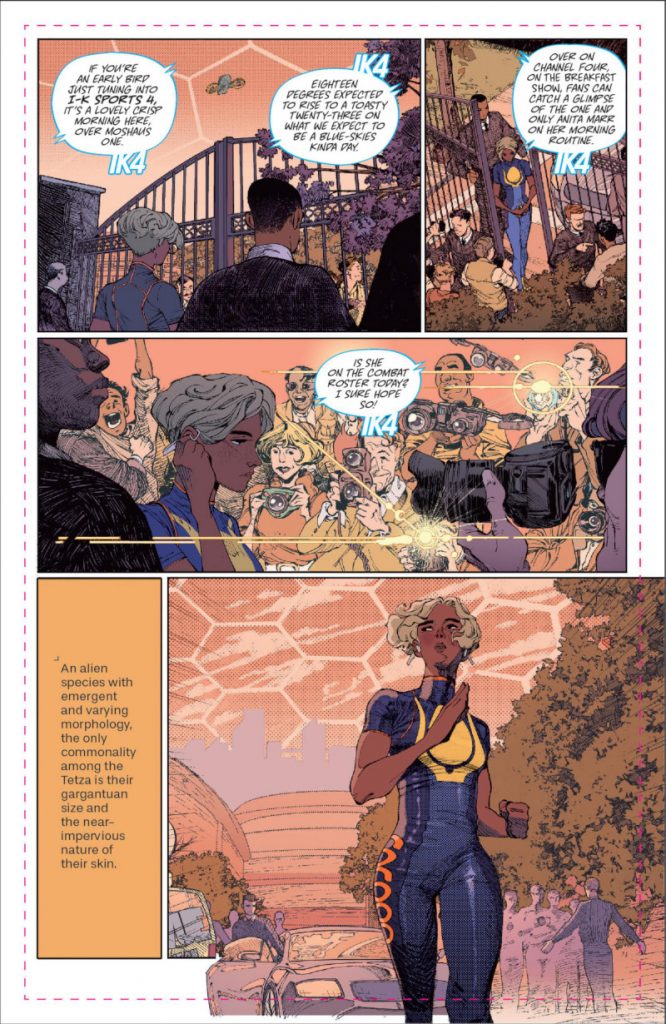
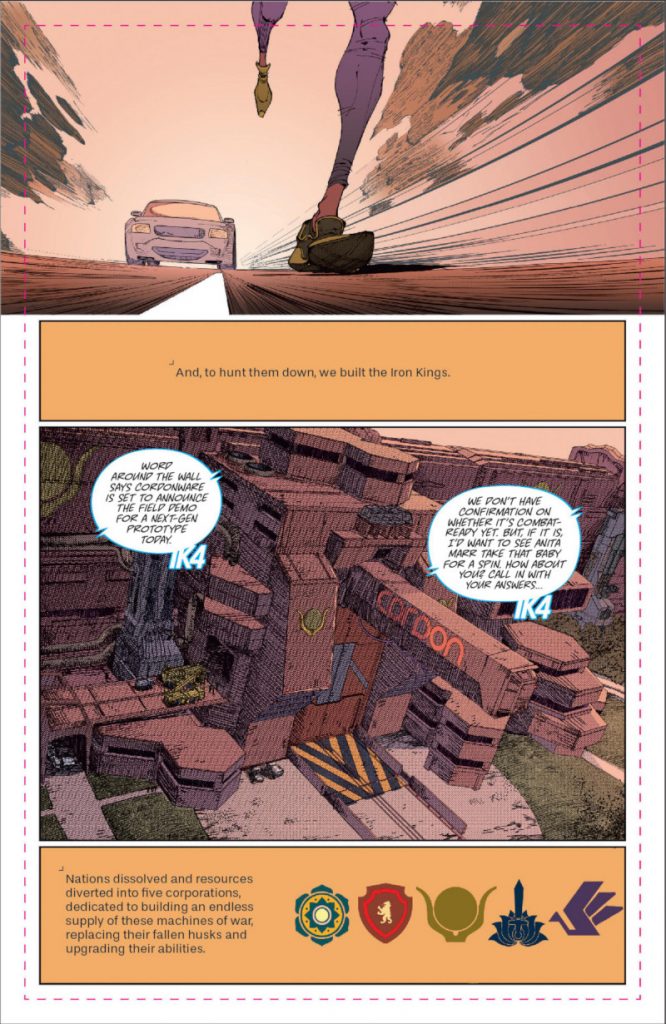
And then he pitched you on Dawnrunner and you said no, right, Evan?
Evan: Yeah, I was like, “Garbage, top to bottom.” (laughs)
Ram: “But I’ll do it because it’s got mechas and kaijus.” (laughs)
Evan: I don’t know what it was specifically that appealed to me because it was like he had just sort of grabbed all my favorite things and said, “Hey, would you be interested in all of your favorite things happening at once?”
Good job by you, Ram.
Ram: Hey, look, I have this. People always keep asking me, “How do you find all the most amazing artists to work with?” I worked with Anand (RK, Ram’s collaborator on Blue In Green), I’ve worked with Evan, and frankly I’m astounded that more people don’t just go, “What would be cool for an artist to draw?” Then look at their work and go, “Yeah, I think this artist would love to draw something like this.” I can already see it in Evan’s work. He loves scale, he loves the sort of big emotive moments as well as the grand visual moments. And so, it was quite easy to pitch this to Evan, certainly in a way where he thought, “Oh, Ram’s going to just give me everything I want to draw.”
That’s a pretty good pitch.
Evan, I had told Ram this before, but I first discovered your work when you were doing the covers for Strange Skies Over East Berlin at BOOM!
Evan: Oh yeah, that was my second cover assignment ever.
They’re fantastic. I really love them.
Evan: Oh, thank you.
It immediately put me on notice about your work. But you haven’t done a ton of published work for interiors, at least as far as I know. On your website you have some pages from Catwoman and from Superman and the Authority, and then you have some I think more either personal projects or projects that weren’t as kind of widescale as those. And so, I don’t want to say that you’re not familiar with interiors, but a lot of people are not familiar with your interiors. Is Dawnrunner the first series that’s all yours, something you’re building from scratch and doing all of?
Evan: Yeah.
How is that?
Evan: I don’t know that I would recommend starting with your own thing. Sometimes I feel a little precious about it, and I’m sure Ram is laughing at me. But I think there’s something that happens when you work on other people’s projects that can kind of take a little bit of the edges off your preciousness, which will enable you to do better work that’s faster later, if that makes sense.
So, when I did that Catwoman issue, what was that? 32?
Ram: 32, I think. Yeah.
Evan: 32. Super-fast turnaround, much faster than I was thinking, much faster than I was working on Dawnrunner because there’s a schedule that needed to be adhered to and there’s a bunch of other moving parts. Other people waiting on stuff from me, and I was like, “Oh, right.” I don’t get to just savor these pages and revisit them and noodle on them and be like, “Oh, this the best camera angle? Is this the best way to get the emotion across?” I had to just sort of fly through it and trust that my first instinct or so was okay, and I think broadly it was. That was a good learning experience for me. It taught me not to be so precious, but to trust my instincts a little better.
Ram: I love drawing and I have done some measure of it. When I first went into a life drawing class, I remember the instructor there made us draw this 10-minute pose with a live model in front of us as we drew it. And he went, “I want you to draw the next pose on top of this one.” The point of it was that you were meant to destroy the previous pose. That’s a very dramatic example, certainly to someone who doesn’t draw for a living, but it stuck with me, the idea that at some point you have to stop, and you have to be willing to destroy prior work. You have to be willing to accept imperfection on the page. And I think that is the push and pull of collaboration, right?
When I work with someone, I want to work with someone like Evan, with someone like Anand, people who are instinctively perfectionists. I don’t want to work with someone who is like, “Yep, five hours, did my page. Here you go. I’ll see you later. I don’t think about work after 5:00 PM.” I can’t deal with that stuff.
But I think my role when it comes to these kinds of collaborations eventually is to go, “Hey, you know what? We’re making a book. We’re not making one page, we’re making a book. And sometimes that means you’re going to be unhappy with a page and it’s okay. I’m unhappy with stuff I put down on paper all the time.
Evan: But I will say that you’ve been remarkably patient when I’ve taken far too long on a fight scene or something because something sticks in my head, or I have a funny feeling.
Ram: Yeah, but I can tell when you’re trying to get to something versus when you’re just obsessing over it.
Evan: Just spinning my wheels complaining.
Ram: That’s the great part of collaboration, right? Other people can always tell. When I have script issues, I’ll struggle with something for four days, then I’ll send it to Dan Watters or Alex Paknadel, have a literally 10-minute conversation, they’ll be like, “Oh, yeah, you need to do this.” And I’m like, “Why the hell didn’t I do this four days ago? Why the hell didn’t I send this to you four days ago?”
Evan, I think you have four advantages. One is you’re very good at art. You clearly take to this very well and anybody who looks at the comics page on your website knows that. Two, as far as writers go, Ram is a very visual person. It’s clear just reading the first issue, that you have a clear vision as to what you want, especially when it comes to the narration complimenting it. You want it to have a certain feel. You also have teammates like Ram and then you have Aditya (Bidikar, the title’s letterer), and then you have Dave Stewart coloring you. Dave has basically colored everyone that has ever lived in comics, so that’s an extreme advantage.
Then the other thing I want to bring up is something we talked about a bit beforehand. You’ve done concept work for games like one called Yara’s Revenge, which to some degree an aesthetic and conceptual overlap to this. How do you feel like having all that in your back pocket, having Ram and Aditya and Dave as go-to people you can talk to if you have any questions, having that concept art experience…do you feel like that really helped prepare you for something like Dawnrunner?
Evan: Yes. Full stop. I mean, you already said everything.
I was too thorough.
Evan: I have the best collaborators that I can ask for. It’s an embarrassment of riches really, and I’m so fortunate that this thing fell in my lap. Because yeah, I don’t think everybody’s first book out of the gate gets this much support. And yeah, it helps that I already had a career in video games and concept art and all that. There are some differences between the two industries obviously, but there’s also an awful lot of overlap. And so, when Ram hands me a page full of question marks, “What does this look like? What does that look like?” I know what my job is. I know what to do.
Ram: I think Evan’s probably the most intellectually organized artist that I’ve worked with. And what I mean by that is, there’s an astounding amount of prep work that he does before he gets to actually drawing on the pages.
Evan: I’m like a method artist.
Ram: Yes. Even to me, yes. So, he’s definitely walking around his home dressed in giant armor and I’ll be like, “I wonder what this feels like.”
Evan: Scale, man.
Ram: To give you an example, he designed the entire Dawnrunner mech and then had parts of it 3D printed so he could truly have the object in front of him. So, when he was visualizing poses, he wasn’t creating visual errors, he was working off a model, which is fantastic. He had color sheets for uniforms and color sheets for the mechs and aesthetics for the mechs from different corporations because they’re from different countries. So, I’ve never worked with anyone who put in that amount of work before a single panel was drawn.
Evan: But this comes from game land. When I’m art directing a game, that’s the task in front of you. Just to create the world. Before anything is modeled, before anything is animated, what is it we’re actually talking about? And so yeah, I’m again fortunate that I got handed a world that had so many question marks in it. “Why does this work the way it does? Why does this other thing work the way it does? How do these people live? Who are we focused on?” It’s as granular as I want it to be. And in the first issue, I was very granular because I was like, “I have no idea what Ram is going to send next. He could ask for any sort of thing.” I have to design what porta-potties a hundred years from now look like.
I bet they look great.
Evan: They look amazingly similar.
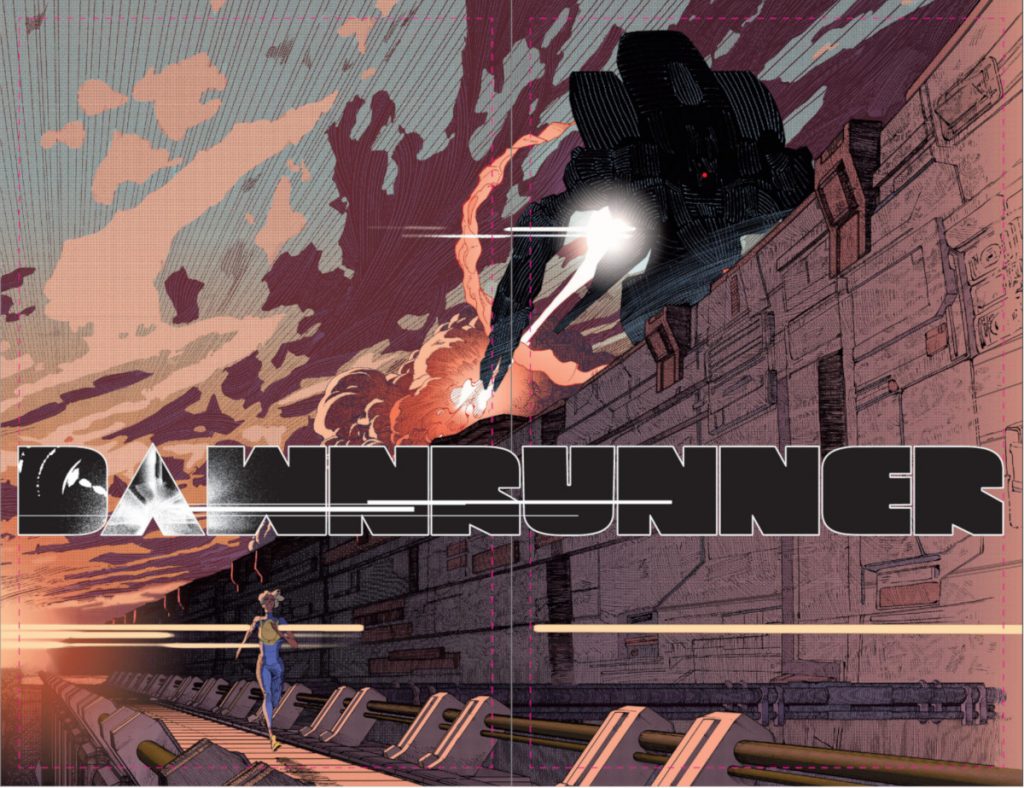
Let’s talk about the comic itself, and I want to do that by talking about a few of my favorite things from the issue. I have an entire list. One is simple. I think I’m going to be the only person who brings this up just because I’m an idiot. But I just love the fact that this book, which is called Dawnrunner, opens with its lead character running in the morning. I don’t know if that was intended as a reflection, like, “Look, this is a person going for a run at dawn.” But that culminates in that amazing title page where it shows Anita running at dawn as Dawnrunner goes out on its test. That was this weird simpatico perfect mix of writing and art that I absolutely loved. I don’t even have a question. Good job by you guys. That was just great.
Ram: Thank you. Totally intentional.
It made me laugh also.
Evan: Also, that spread is actually twice as big as you think it is.
Ram: Oh yeah. It was. It was literally four pages.
That’s not as uncommon as you might think. There were these Marvel trading cards back in the 1990s, and what most artists would do is split Bristol boards into quarters and then they would draw them in quarters and that would give enough space. But Art Adams couldn’t get the detail he wanted in the quarters, so he would actually draw them as full bristol boards.
Evan: Classic Art Adams.
He keeps drawing full pages, even though he doesn’t need to draw full pages. But that allowed him to get to the detail he wanted in the piece.
Evan: And that right there is why the original inks for the covers of Dawnrunner are 24” by 18”.
Because you couldn’t get the effect you wanted without that size?
Evan: Yeah.
Ram: The amount of struggle we had trying to compress the image files in a way that wouldn’t cause the printers to go, “I don’t know what to do with this.” We had quite some time dedicated to, okay, we can definitely print this detail without the pages going crazy.
Evan: Printers hate this one secret, ask me more.
I wanted to ask about that title page in specific for you, Evan, just how that was put together. There’s all these textures. If you look at the wall on the page, there are all these etchings into it, and then you look on the sides and there’s flares and there’s these scratchy light and dark clouds. There’s a lot to it. And it made me wonder where the line is drawn between you and Dave when it comes to the art, because some of those things I’m unsure as to who is handling what. Are the flares you? Or are those Dave? Is there kind of a blurry line between some of the effects on the page and what Dave is doing?
Evan: No, I try to give Dave as close to a gray scale version of the values. I don’t tend to paint anything but the backgrounds. I don’t tend to paint the characters or anything because I want to leave that up to whoever’s coloring. But at least the values of it, at least in ink, to give some indication of where the color lives and where to go sort of nuts with it.
Ram: If anything, having observed both Dave and Evan collaborate, I think part of what makes Dave such a great colorist, not only on this book but on everything he’s done is, it’s very difficult as a colorist to really color a book in a way that adapts to the artist who is drawing that book. A lot of colorists have their style, and if it meshes with the art, great. If it doesn’t, too bad.
I could count probably on one hand, the colorists that I would look at and go, “they’ll color any artist well.” For example, Matt Wilson can color a myriad of different artists and he will change his approach depending on what they need. And I think Dave’s understanding of color and what the pages need is very similar to that, in that he knows how much to do with Evan’s pages. And frankly, Evan’s pages have so much detail, and that is certainly a visual language aesthetic that’s very prominent on the page. There is just a lot of detail.
Evan: And Dave doesn’t add either. I have to say, he’s not afraid to let me fall on my ass and I won’t see it until…really, I won’t see it until he’s colored it.
Ram: He had to go back and say, “Actually, Dave, I think we might need some light and shadow rendering here.”
Evan: Or in fact, there was a page on the very first issue with an incredibly rendered… I mean, it took me a day to render out this forest behind Dawnrunner, and by the time Dave colored it was like, oh yeah, that’s overkill. We need to get rid of that entirely. Get it out of there. Yeah, just take it out. So a lot of times, Dave is the best kind of editor because he’s doing it in his coloring. He’s like, “Did you mean this?”
“Is this necessary?”
Evan: Yeah. And oftentimes I’m like, “Yep, that’s exactly what I meant.” But every now and again I’m like, “Oh, wow, yeah, I totally dropped the ball there. I don’t want that. Let’s get rid of it.”
That’s why you work with pros like Dave.
Let’s talk about another thing in this comic. At the core of this story, you have the idea of the Tetza, these big monsters that come through Schwarzschild Bridge over Guatemala and how quickly the world turns to building a giant wall, because that’s what we do, and build giant mechs to fight them, called the Iron Kings. But my favorite part about it, and something I thought was deeply fascinating about this, is how the Iron Kings, these giant mechs built to protect the world from monsters, are quickly turned into sport. I am a big sports guy, and so I’m not surprised by this result.
Anita Marr, the main character, is the best at this sport. She’s at the top of the rankings. She has this jerk Xander who’s like, “I’m two behind you on the kill list,” as if that’s a very good thing to say in your life. She also seems to be one of the most famous people in this version of the world because of what she does. But what appealed to you both about not just making this a story of protection as it appears on the surface, but one where your saviors are quickly commercialized? Because that’s a fascinating layer to this story and one I love.
Ram: Yeah, I mean, we look at the world today, right? 24/7 news coverage of people killing people and analysts are brought on to say, “Can you explain to us the merits of this military maneuver?” And the analysts are like, “Well, it was a really interesting day.” It’s not interesting. It’s war. People are fighting to survive. Stop turning this into some kind of entertainment. And I think that speaks to our modern need to commodify everything. And so, it then figured that in a world that is neo-utilitarian, if you will, and that everything is to make the next Iron King.
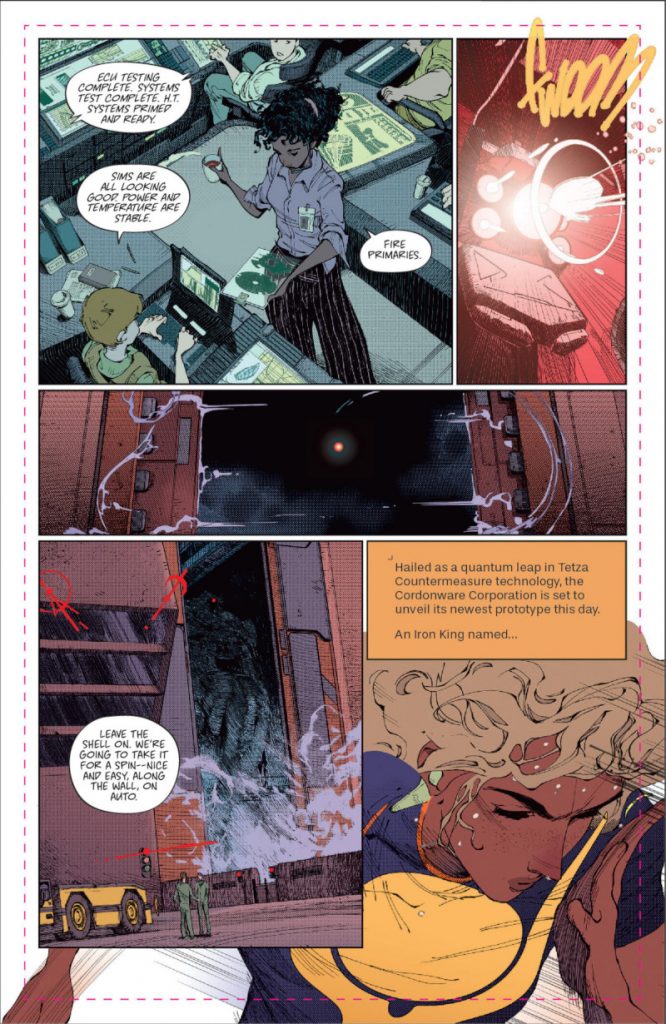
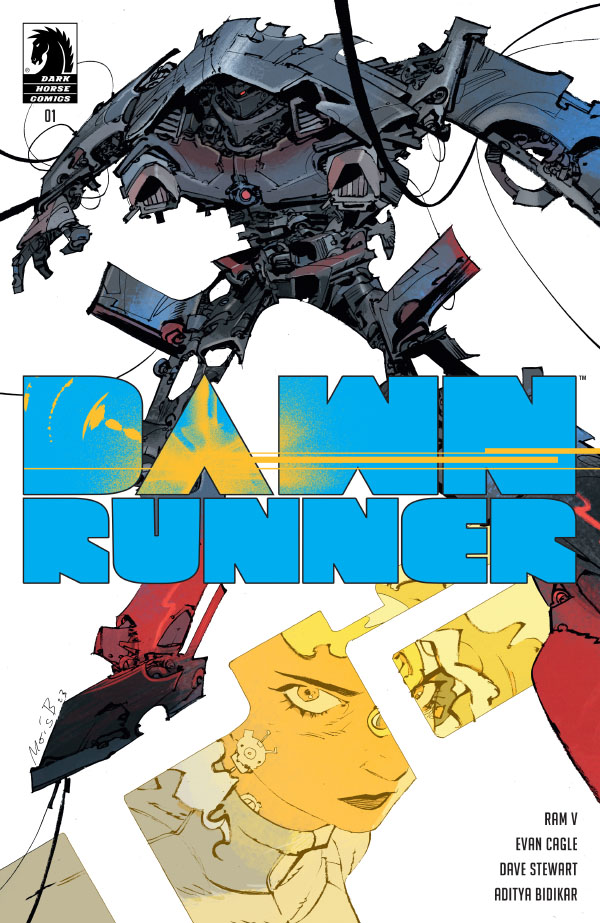
It’s in service to this one thing.
Ram: Yes. Then humanity’s struggle is also utilized for entertainment and profit and commercial gain.
Evan: And there’s no shortage of stories about people who are uncomfortable with fame, right? There’s not a single person whose name you know as a celebrity who will tell you that fame is great. Never in history has there been one person who’s like, “Oh, yeah, fame is totally where it’s at.” Not one. Everybody hates it. They achieve it and immediately regret it. And so this is well understood as a trope almost of celebrity, but what if that celebrity is actually tied to people living and dying? So you’re really conflicted now, because not only are you uncomfortable with your own fame and the sort of dehumanization that comes with that, but also you kind of have to keep fucking doing it because there’s no other choice. You’re literally the one who’s standing between your adoring public and their demise.
That’s super interesting to me. It’s easy enough to decide to quit football or to quit movies or to sort of garbo your way into a cave somewhere and want to be left alone. But what if people lived or died on whether your sports team won?
That’s interesting to me.
I feel like Xander would quit. Anita wouldn’t.
Ram: Wow. We shall see. We shall see.
I also want to point out that this story is about… To come back to the original question we started with, genre versus granular human stories, I feel like I’m kind of explaining my own metaphor at this point, but on one end she wears giant armor and goes out and fights monsters. On the other end she wears giant armor and goes out and faces cameras, if you see what I mean. And through all of it, maybe the question that the series is trying to ask is, who really knows Anita Marr? Who really understands Anita Marr? And how do you understand someone? Is it Dawnrunner given how the issue goes? So I think trying to find human connection in a world that sees you as anything but human is also perhaps a theme that we’ll find that repeats itself towards the series.
Poor Dawnrunner. It and Anita meet for the first time and they’re building this connection and she’s just thinking of her ex, Kylar.
Evan: Isn’t that the way?
Ram: She doesn’t trust Dawnrunner yet.
I get it. I was joking, but going back to what Evan is saying, if this is a battle of life and death, both for humanity and for yourself, you want to trust what you know. And she knows Kylar, she doesn’t know Dawnrunner. God, these sound like weird names for a future Kardashian show or something. Kylar Kardashian.
Evan: I want to know what happened to Kylar. I want to know where Kylar is.
Kylar was sent to a farm upstate.
Ram: Volume Two.
Evan: In issue two, there’s a shot of people in a sports bar and a couple of them have signs, and I thought about having one in the background saying, “Where’s Kylar?”
You should have done that. I would’ve loved it.
Evan: I should have done that. We haven’t gone to print yet, so maybe that’ll be there.
The thing I think is impressive about this book is…it’s a funny thing to say about a book that is ultimately not about these things. It’s not not about these things, but they’re elements of the world more than they are about really what the book is going to ultimately be about. It’s like the Pacific Rim to the Arrival of the rest of it. But the Pacific Rim parts are so interesting that I feel like you could almost make a Lazarus like sourcebook that’s just a look at the sport and how big a part of the economy betting on these fights have become. I bet it is huge. People would go nuts for that.
And then also speaking of Lazarus, one of the things that’s interesting about this world is that nations have dissolved and been replaced by five corporations, which is a very Lazarus-like idea. It’s super fascinating that I could just have a book about this world, and I feel like I would just drink in the details because it’s so rich even just from the one issue. You’ve got me hooked and I haven’t even gotten to the part that is actually the meat of it.
Evan: This is why we joke about doing some sort of follow-up afterwards. There’s so much material.
Ram: Where the story ends certainly is a complete story from issue one to five, but it doesn’t have the kind of finality that a lot of my other books have, like These Savage Shores or Blue In Green. So, it’s certainly something that we could potentially return to at some point.
I also like that a lot of this stuff that I’m talking about grounds it both for that present reality but also makes it feel like there’s a path to getting there ourselves. Obviously, there’s not been a lot of portals that have opened that have brought kaiju into our world yet. Fingers crossed that doesn’t happen.
Evan: Yes.
Going to Anita in specific though, who has a very striking look. When she’s walking into the bullpen, she has this very Tracer from Overwatch type look that makes her stand out. But the thing that I think is really interesting about her is, she is doing this because she knows it’s necessary, but it doesn’t feel like she loves what she does in a real way. What makes her such an ideal entry point into this story and world?
Ram: I don’t want to spoil too much, but issue two quite literally begins with the reason why she’s doing this. And so there is quite a lot to tell and it becomes quite central to the plot and the conflict. But yes, that’s someone who is seen as top of the kill list. She’s the best pilot and goes out and decimates these things. Thousands of people cheer every time she kills one of these Tetzas. But to see that character behind the scenes as a reader and understand that, oh wait, this is a person who was way more compassionate than I thought she was going to be, who’s way more sensitive, way more reserved than I thought she was going to be, I think it makes the character interesting. It takes away from that sort of grandiose trope of, oh yes, the hero must always be the loud, sort of big, “I shall lead you into the light” kind of character. And then it starts making you question, okay, then why is she doing this? So we’re successful in that sense.
Evan: I think issue one is maybe your experience of her as you would know her from TV. And issue two is, who is she when the cameras are off?
Ram: And I think issue two does that for a lot of characters, including a character called Lestern in this issue as well. He’s the head of Cordonware, and I think there are shades of gray, grayer, and maybe black to Lestern that become more apparent as the issues go on as well. And I think what I was trying to get to, okay, what’s the point of using this window? The story is still a character piece in that sense. It’s looking at all these characters and their motivations and their layers, even though we’re talking about a story of giant mechs and monsters fighting each other, and there’s a lot of that on the pages.
I do have to ask about the giant mechs and monsters of it all, because you have to make these look cool. The Tetza look cool, and you don’t get a great look at Kylar, but Kylar kind of seems like bulky and classic mech looking, while Dawnrunner is this sleek ultra killing machine. You get this look at it the first time it slides onto the page and you’re just like, “Holy shit.” I haven’t even seen the other Iron Kings and I’m like, “I know this one is the best.” Evan, when you were digging into it, how did you go about differentiating Dawnrunner from the infinite number of mechs that have been built and drawn and designed that are out there in the world? Was there a guiding light to making this look as cool as it does, or is it just feel and vibes?
Evan: I mean, how long have you got?
We’ve got to have buy-in to the Dawnrunner being the best, right?
Evan: Yeah.
Ram: I mean, you say feel and vibes, but I was there for every conversation where you were like, “I don’t want this to remind people of this. I don’t want them to think of this when they look at this.”
It doesn’t remind me of anything. I can say that.
Evan: I mean, I guess in short, Dawnrunner is the essence of all my favorite mech designers. There are pieces of Dawnrunner that are reminiscent of other mechs, but it’s a distillation of all my favorite mech characteristics. Guiding that was the idea that in silhouette, lined up with a bunch of Gundams, and a bunch of EVAs, and a bunch of Valkyries, Dawnrunner’s silhouette should be Dawnrunner’s. You should be able to pick it out of a crowd.
And so, it’s got these massive overblown legs that are just…I mean, they’re bordering on absurd. They’re so outsized with the rest of the body and these arms that are kind of super muscular, and I wanted it to be exaggerated in certain places so that it didn’t feel like just another mech.
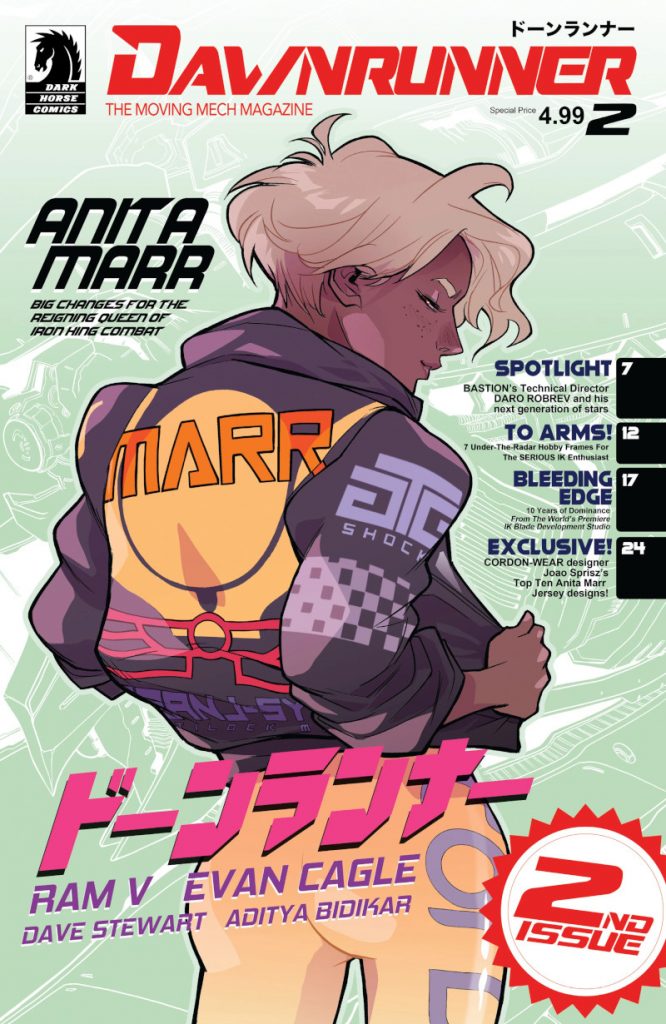
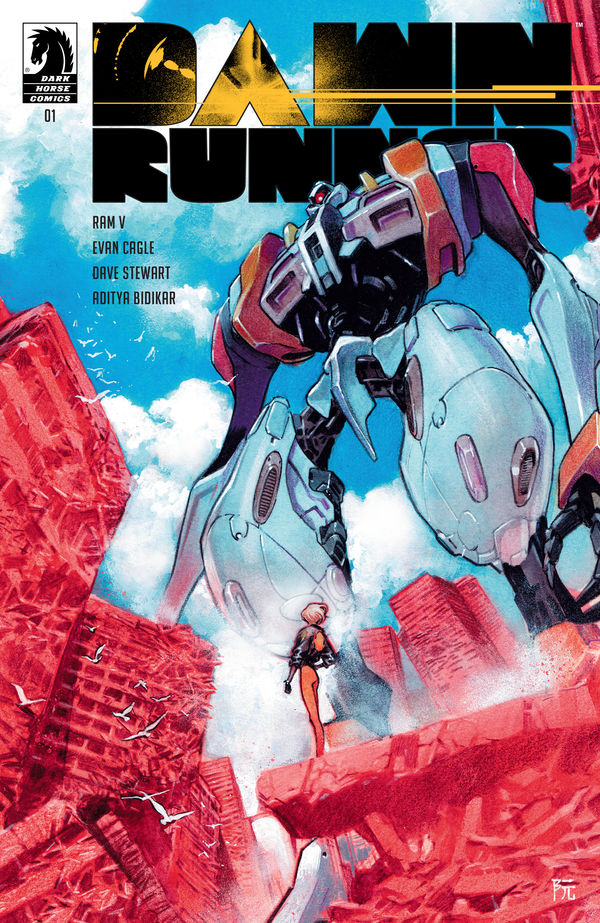
I feel like I’m doing an interview with the designer of Dawnrunner on IK4, the in-world sports network.
Evan: Oh, man. You should see Karl Kerschl’s cover.
Oh, Karl’s a big mech guy.
That’s one of the funny things about mechs though isthe people who are really obsessed with mechs are always building models of mechs, and so if you get one little thing wrong, people are going to know. Did Karl see the model of Dawnrunner?
Evan: Oh, yeah. I sent him turnarounds of it.
I’m sure you did. I’m sure he asked for them.
Evan: It was great because Karl has done kind of a homage to a Newtype cover. It’s populated with a lot of text, and he was like, “So, you guys want to weigh in? What’s the text on this?” And so, Ram and I are coming up with just pages worth of possible headlines. It goes into the whole sort of digging into the world mythos thing, but what’s on the cover of an IK magazine? As an IK enthusiast, what’s on the cover?
Ram: It wouldn’t be out of place to see a giant cover story about IK’s interview with Dawnrunner’s head designer.
Evan: Exactly. So, there’s tons of stuff like that on there.
I guess the easy answer for a hard question is that I felt like I would know what Dawnrunner looked like when I got there and just kept going and kept iterating on it. And I remember one of the big moments was hitting on its face because that was going to be where you project your emotional connection to him. And so the decision to make him mono eye versus bifocal was kind of a turning point. It was like, “Oh, okay. That’s what his symmetry looks like.”
I do like the first shot of Anita and Kylar together. It looks like what you would see if there was an in-world video game about them, their select screen. “Oh, you want to play as Anita and Kylar? Here’s what you see.” It’s like Marvel vs. Capcom or something.
Ram: I think our reference for that was Russian propaganda posters.
Oh, yeah, that’s good too. I see that for sure. It’s funny, when I interviewed you the other day, Ram, I talked about how it’s like I didn’t want to talk about a lot of the plot stuff because I feel like it’s spoilers. I feel like I still haven’t spoiled much of this book.
Ram: No, we haven’t talked about plot much at all.
But like two thirds of it is very much all these world-building elements, and then the third kind of pulls the rug out from under you to some degree and it becomes something different. I don’t even really know how to ask about it because I already know that is in a lot of ways the main focus. The connection and everything. But, how do you talk about this book that is very specifically this big kaiju book that’s really awesome and has all these cool world-building elements, but also has this heart to it that is going to probably be more important and also is different, but you can’t really talk about without completely spoiling your own story?
Ram: I always tell people…have you watched the movie Frequency?
Yes.
Ram: Where they talk on the radio decades apart. Well, add that to your favorite kaiju mecha book.
I like it.
I did want to bring up one other thing. You two created a promotional video graphic for the book on social media. I absolutely loved it. I was already sold because Ram previously had made that comparison Arrival/kaiju comp on the podcast. But that video…the sound is amazing, the look is amazing, everything about it. I hadn’t seen anything like that before in comics. Why did you guys decide to do that?
Ram: I wanted to make a trailer and Evan’s a masochist.
Did that take you six weeks or something?
Evan: It took me…
Ram: The equivalent of six weeks.
Evan: Yeah, I compressed six weeks into a weekend.
Wow.
Evan: Yeah. It goes back to my history in games and in shilling for games, making marketing material for games and having crazy deadlines and not sleeping for 72 hours and that sort of thing. And so yeah, I think we heard from Dark Horse on Friday that next week we were going to announce Dawnrunner, and I was like, “Well, time to get to work.” And yeah, we kicked it out. As far as why did we go that route? I think it just comes down to because we could.
Ram: That ten second thing says more about… Not even 10 seconds, is it a six second thing?
It’s like five seconds probably.
Evan: Yeah.
Ram: It more about the book than hours of me trying to explain to people what it’s going to feel like or what it’s going to be like. So yeah, I’ve always been a big sort of believer in, just look at it. If you like it, take it. And so, I think that five second thing is very impactful…I would grab the book if I looked at that.
You have to get Dark Horse pumping some Instagram promotional money in there to get that out in front of people. It’s great.
Speaking of Dark Horse, Ram, you have a DC exclusive, you have a book at DSTLRY, you have two books at Image, and you have a book at BOOM! Why was Dark Horse the right fit for Dawnrunner?
Ram: Well, there is a long history to that. I published Grafity’s Wall in the UK through Unbound, and Konner (Knudsen), who’s the editor on this book, found that book, and to my understanding, walked into Mike Richardson’s office and went, “We should be publishing this. It’s not available in the American market.” And that’s how Grafity’s Wall had its special edition at Dark Horse.
And so right after that, Konner came back to me and said, “Hey, I would love to work with you on something.” And I said, “Cool. I’ve got this book called Dawnrunner that I’m thinking of working on next.”
This was also at a time when I had decided that I want to work with major publishers in the comics market to see really, “Okay, where am I most comfortable? What are the deals available? What can I do? What does one publisher offer that another can’t?” And this came along at that time, and Dark Horse were great to work with. They offered a great deal for us, so I ran the deal past Evan, and we were happy with it. So, lo and behold.
Boom.
Evan: Not BOOM!, as the case may be.
I like what you did there. (laughs)
Is there anything else you would like to add about the book? Because there are levels that I don’t want to get to, but Ram, you know your levels better than I do. Is there anything you want people to know before we go about everything that is Dawnrunner?
Ram: I will say this…it’s the book where every time the pages for the book come in, I am excited in a way that I forget I’m the one who wrote the book in the first place. I look in the book and I go, “Oh my God, this is going to be amazing.” And then I go, “Wait, what’s going to happen next?”
Evan: The same goes for me. When Ram’s pages come in, I’m immediately like, “Oh, what happens next?” And he’s like, “I’m writing it still.”
This is a weird place to close because it’s an interview and I’m closing with something from me, but I will say this. I read it twice already. I read it once on my iPad in single pages just going by, and then I read it on my computer on a big monitor because I wanted to be able to have the spreads together. And this is the type of book that you need to read on either the biggest screen you have possible or in print. And it’s not just because it’s Kaiju. It’s because of the storytelling. It’s so incredible.
Obviously, I haven’t read the rest of it, but Evan, this is definitely the best thing I’ve ever read from you because it’s the only thing I’ve read from you. And Ram, I honestly think this could be one of the best things you’ve ever done. I think it’s incredible. So good job by you guys.
Ram: Thank you.
Evan: Oh, thank you.
Ram: Yeah, it’s always the endeavor. Always one up yourself.
Thanks for reading this interview with Ram V and Evan Cagle. If you enjoyed what you read, please consider subscribing to the site for more like it.
The studio/collective Ram is in with fellow writers Dan Watters, Alex Paknadel, and Ryan O’Sullivan.↩

